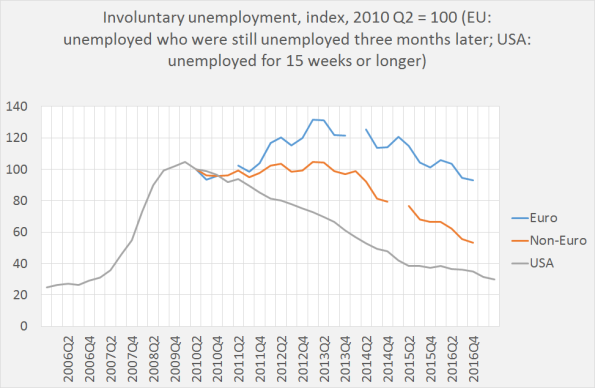In the USA and the EU, employment is up and unemployment is down. But unemployment is not yet low. Unemployment rates have to decline more (a bit in the USA, a lot in the EU) and participation rates have to recover (a lot in the USA, a bit in the EU). In the EU, there are large differences between countries (compare Spain with Germany). But on the macro level, there is still a large reservoir of involuntary unemployment and, looking at the participation rates, people who have given up altogether. For practical reasons (it always takes time and effort to find a job), unemployment will never be zero. But we can account for this and look at “involuntary unemployment” only. In a statistical sense, we might define involuntary unemployment as the number of unemployed which, after a
Topics:
Merijn T. Knibbe considers the following as important: Uncategorized
This could be interesting, too:
tom writes The Ukraine war and Europe’s deepening march of folly
Stavros Mavroudeas writes CfP of Marxist Macroeconomic Modelling workgroup – 18th WAPE Forum, Istanbul August 6-8, 2025
Lars Pålsson Syll writes The pretence-of-knowledge syndrome
Dean Baker writes Crypto and Donald Trump’s strategic baseball card reserve
 In the USA and the EU, employment is up and unemployment is down. But unemployment is not yet low. Unemployment rates have to decline more (a bit in the USA, a lot in the EU) and participation rates have to recover (a lot in the USA, a bit in the EU). In the EU, there are large differences between countries (compare Spain with Germany). But on the macro level, there is still a large reservoir of involuntary unemployment and, looking at the participation rates, people who have given up altogether.
In the USA and the EU, employment is up and unemployment is down. But unemployment is not yet low. Unemployment rates have to decline more (a bit in the USA, a lot in the EU) and participation rates have to recover (a lot in the USA, a bit in the EU). In the EU, there are large differences between countries (compare Spain with Germany). But on the macro level, there is still a large reservoir of involuntary unemployment and, looking at the participation rates, people who have given up altogether.
For practical reasons (it always takes time and effort to find a job), unemployment will never be zero. But we can account for this and look at “involuntary unemployment” only. In a statistical sense, we might define involuntary unemployment as the number of unemployed which, after a reasonable time, still have not yet found a new job. Available data led me to set this ‘reasonable time’ to one quarter for the EU and to 15 weeks for the USA, the data are shown in graph 1 (German data not available!). In the USA, there are still over 2 million people who were unemployed for 15 weeks or more. Which is way lower than in 2009 – but still 2 million. The comparable figure for the Euro zone is, ahem, 9,7 million and for the non-Euro zone EU about 1,7 million. And though the employment to population ratio in the USA is finally rising in a serious way, it is still way below the per 2008 level (let alone the much higher level of the end of the twentieth century). Aside – the nefarious consequences of the combination of monetary tightening and government austerity in the Euro zone after 2010 clearly show.
Meta: John Maynard Keynes once invented, or at least popularized, the word: “involuntary unemployment”. This means something as: “even when the unemployed are willing to accept a wage cut to find work – they won’t find it”. To restate this in the language of modern data on labor market flows: “even when, during a slump, the wage rate is cut this won’t increase the net outflow (gross outflow minus gross inflow) from the reservoir of unemployed”. One of the reasons for this is the non-existence of individual wages. A wage cut is not a wage cut for an individual worker – but a cut to the ‘market rate’, a ‘wages cut’. That’s the way labor markets work. And worked: historical data on wages very clearly show the existence of very stable market wide wage rates for carpenters, agricultural labor, masons and whatever even in a time when government interference with wage rates was much less than today.
Update: more meta. The way the unemployment data used above are measured ensures that it shows that on the individual level ‘measured unemployment’ is involuntary too, as the unemployed are asked if they are actively trying to change their situation. This is related to but not the same kind as the ‘involuntary unemployment’ referred to above which is probably best explained by the fact that the people in the unemployment reservoir might, in one year, be very different people than in the preceding or the next year. A not entirely satisfying aspect of the definition of involuntary unemployment used above is that even when people get new jobs quite fast they still might encounter many short spells of unemployment, leading to high average unemployment.
